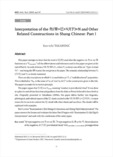

PARTNER
검증된 파트너 제휴사 자료
Interpretation of the 勿/毋+巳+V/(于)+N and Other Related Constructions in Shang Chinese: Part I
방대한 850만건의 자료 중 주제별로 만들수 있는 최적의 산출물을 해피 캠퍼스에서 체험 하세요 전문가의 지식과 인사이트를 활용하여 쉽고 폭넓게 이해하고 적용할수 있는 기회를 놓치지 마세요
37 페이지
최초등록일 2024.01.29
최종저작일
2023.12

-
 * 본 문서는 배포용으로 복사 및 편집이 불가합니다.
* 본 문서는 배포용으로 복사 및 편집이 불가합니다.
미리보기
서지정보
· 발행기관 : 세계한자학회
· 수록지 정보 : 世界漢字硏究 / 6권 / 2호
· 저자명 : Ken-ichi TAKASHIMA
목차
1. Introduction
Zhū Shēngyù’s Comments
Examination I: Zhū Shēngyù’s Questions and Zhāng Yùjīn’s Interpretation
Abbreviations of Terms
Abbreviations of the Titles of Oracle-Bone Collections and OtherReference Works
References영어초록
This paper attempts to show that the word sì 巳(祀) used after the negative wù 勿 or wú 毋 functions as a “Vintransitive” (all the abbreviations and references used in this paper are given at the end of Part I). As such, it forms a VP, 勿/毋V1V2, where V2 is always one of the six “Type-A ritual Vs”—one being dăo 禱 ‘to pray’, the rest given in the paper. The semantic relationship between V1 (巳/祀) and V2 is closely examined. There are also inscriptions in which V1 is used before yú 于, a “multidirectional” preposition. This is labelled as “Nloc in the sense of ‘in, at’ (not ‘to, for’)” in the construction given in the title. The paper accounts for its motive principle. The paper argues that 巳/祀 is a Vaction meaning “conduct sì-providential ritual”. It was done at a place to seek divine direction and guidance from the deity or Power believed to have dwelt in situ. Originally presented in Takashima (2009a), this paper delves further into linguistic, philological, and cultural aspects of the 巳-ritual couched in the VP, 勿/毋V1(=巳/祀)V2. A major reason for its use is to contrast the 巳-ritual with other rituals and sacrifices. The details will be explained with examples. Part I covers “Examination I: Zhū Shēngyù’s Questions and Zhāng Yùjīn’s Interpretation”. The paper answers the former and evaluates the latter. Part II begins with “Examination II: Qiú Xīguī’s Interpretation” and ends with the conclusions of the entire paper.참고자료
· 없음태그
-
자료후기
Ai 리뷰지식판매자가 등록한 자료는 주제에 대한 깊이 있는 분석이 돋보입니다. 과제를 작성하는 데 큰 도움이 되었습니다. 앞으로도 이런 좋은 자료가 많이 등록되기를 기대합니다. -
자주묻는질문의 답변을 확인해 주세요

꼭 알아주세요
-
본 학술논문은 (주)코리아스칼라와 각 학회간에 저작권계약이 체결된 것으로 AgentSoft가 제공 하고 있습니다.
본 저작물을 불법적으로 이용시는 법적인 제재가 가해질 수 있습니다. -
해피캠퍼스는 구매자와 판매자 모두가 만족하는 서비스가 되도록 노력하고 있으며, 아래의 4가지 자료환불 조건을 꼭 확인해주시기 바랍니다.
파일오류 중복자료 저작권 없음 설명과 실제 내용 불일치 파일의 다운로드가 제대로 되지 않거나 파일형식에 맞는 프로그램으로 정상 작동하지 않는 경우 다른 자료와 70% 이상 내용이 일치하는 경우 (중복임을 확인할 수 있는 근거 필요함) 인터넷의 다른 사이트, 연구기관, 학교, 서적 등의 자료를 도용한 경우 자료의 설명과 실제 자료의 내용이 일치하지 않는 경우
“世界漢字硏究”의 다른 논문도 확인해 보세요!
-
Yu Mong Chon Cha : Tracing the Development of Sino-Korean Literary Sty.. 16 페이지
-
Research on the Application of Zhong Hua Zi Jing in Teaching Chinese V.. 15 페이지
-
The Semantic Differences of the ‘Three’ in Proverbs and Their Limitati.. 17 페이지
-
Strategies of Graphing Ideas in Shang Oracle Bone Scripts 39 페이지
-
Research on the Syntactic, Lexical, and Stylistic Features of Chinese .. 25 페이지
문서 초안을 생성해주는 EasyAI
